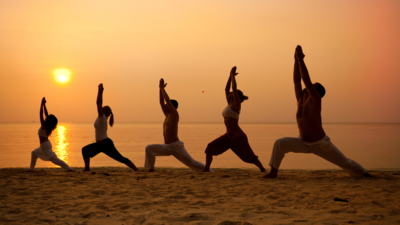ARTICLE AD BOX

For centuries, many have described Yoga as the union of the body, mind and soul. But in today’s context, that union must extend beyond the self. This is the time of climate disruption, when biodiversity is vanishing before our eyes and our generation is burdened by ecological grief, and this is when Yoga might be able to come out as our saviour by transcending its meaning of being a personal practice and instead becoming a planetary ethic.Balance is an important keyword to Yoga, but how balanced really is our world, where glaciers are melting as we practice breathing exercises in an air-conditioned room? The principles of Yoga have always been seamlessly aligned with sustainability, because how do we perform an asana (yogic posture) and forget what we are standing on?This alignment becomes clearer when we return to the foundational philosophy of the practice.
Patanjali’s eightfold path—Ashtanga Yoga outlines a way of living while being mindful of our current ecological reality. When each limb of Ashtanga Yoga is understood and practiced fully, it serves as a guide for planetary responsibility.In popular practice, the first two limbs - Yama and Niyama- are skipped over, but they are where sustainability actually begins.Yama highlights the relationship with the world, consisting of principles like Ahimsa (non-violence): Does what I choose to buy, eat or use harm another life—human or not? And Aparigraha (non-hoarding) which in a world obsessed with accumulation—of wealth and material feels extremely necessary given the urgency of time we are living in.
All of these values play out every day in our daily lives, in what we use, what we waste, what we carry, and what we let go of—this is why they are far from abstract.Niyama focuses on the inner self with principles like Shaucha, usually translated as cleanliness. It asks us to keep our surroundings, along with ourselves, pure. Tapas, also known as austerity or self-discipline is extremely important to live consciously in a world immersed in the culture of convenience, and Santosha or contentment, reminds us to be happy in what little we have and push back against the constant desire for more.Next comes Asana, or postures—this is the limb most people are reminded of when they think of Yoga. But these postures themselves are a reflection of nature and not isolated exercises. When we stretch into Vrikshasana, we take inspiration from the vrikshas (trees), standing tall, steady, and rooted. When we do Padmasana, the lotus pose, we are reminded to remain clear and bloom even amidst mud or filth just as a lotus does.
This is incredibly ironic. We attempt to shape ourselves into nature’s forms while on the mat, but forget what we are becoming the moment we step off of it. If we want to become like the trees, we can’t be the ones cutting them down.Another limb is Pranayama. It teaches us to observe energy as a flow. Inhale, pause, exhale, pause—this reflects how nature works. Breath is the most direct link between humans and the environment.
Every inhalation draws oxygen from plants, and every exhalation releases carbon dioxide, which plants use to sustain life. Pranayama highlights this cycle, this interdependence between humanity and nature.T
hen comes Pratyahara—the withdrawal of the self from external distractions. This means stepping away from noise. The noise of endless consumption. This is the ability to pause and notice what’s enough.Dharana and Dhyana—concentration and meditation—train us in attention. Focus is a form of care. Meditation, when rooted in awareness, creates space for empathy—for forests, oceans, and everything we share this planet with. When you truly pay attention, the Earth is impossible to ignore.The final limb is Samadhi or transcendence. This is a union and also losing. Letting of the illusion that separated the self and the world.
This means recognizing that the soil we stand on, the air we breathe and the water we drink are extensions of the same material that sustains us. This means, we are one with nature and nature is one with us.The eightfold path is more than ancient wisdom needed to be admired, it serves as a guide for real sustainable living. This Yoga Day, we don’t need to stretch further—we need to return closer. To nature. Because if truly understood, Yoga doesn’t just align the spine, it aligns us back with the Earth.By: Shubhanshi Chakraborty, Sustainability expert and a young Author



.png)
.png)
.png)
















 5 hours ago
3
5 hours ago
3









 English (US) ·
English (US) ·